

Refurbishing
Apologies for the dropsheets, paint tins and scattered detritus. More information...

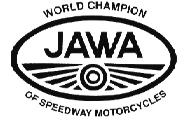
For the first forty years or so JAP engines reigned supreme in speedway, but as the 1960's came to an end all that was to change with the rise of Jawa as a force in the sport.
Jawa was started by a Czech, František Janeček, in 1929. Before that, Janecek had been an engineer and an inventor, patenting and manufacturing his own hand grenade, as well as producing typewriters and sewing machines amongst other things. However, by the end of the 1920's the armaments industry was in decline, and Janecek decided to go into motorcycle production.
Not having time to develop his own engine, he decided to make a foreign design under license. The design he chose was the "Wanderer", a motorcycle with a 500cc ohv block motor with a pressed steel frame. However, instead of just getting a license to manufacture, Janecek ended up with the entire production of the Wanderer, the firm having decided to cease production due to the collapse of the German motor industry, and because they would be in direct competition with BMW.
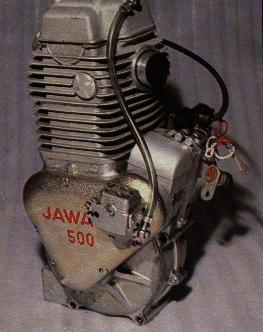
Thus Janecek renamed the Wanderer the Jawa, a combination of the first two letters of his name and of Wanderer. The first Jawa was a 500, the most popular choice for a solo motorcycle in the 1930's. Janecek decided to challenge the 500cc motorcycles dominance of the solo market by producing a single cylinder two stroke, based around the Villiers 175cc motor. By 1933 this motorcycle was outselling all other bikes in Czechoslovakia, and the 500 was taken out of production.
Over the next few years Jawa built two 350 four strokes, although the most interesting to the pre war Jawas was probably the 98cc Robot which had a monoblock construction at a time when virtually all engines had separated gearboxes. Although the Second World War halted production of motorcycles for a time, a newly nationalised Jawa returned to bike manufacturing in 1946 with the Jawa 250, and then the 350. * Although Jawa had been involved in track racing before the war, the company concentrated on the manufacture of road going machines in the aftermath of the war. *(See Foot of Page)
Jawa entered speedway indirectly. Vaclac Stanislav and Jaroslav Simandl were motorcycle racers before the war, and returned to the sport after peace had come. In 1949 the pair were returned home after competing in the International Six Day Trial. Stanislav had bought a connecting rod for his speedway JAP, but wanted a camshaft too. He asked Simandl to lend him the money so he could buy one in France. Simandl told him he would make him a complete engine when they got back home, and during the boat crossing, the camshaft was wagered against a complete engine. Simandl told Stanislav he would build him a better single cylinder engine than the JAP.
Simandl ended up building four engines; once his friends cottoned on to what he was doing and asked him to make them engines. Stanislav took the first engine, and instead of JAP, had Jitka engraved on it - the name of his newborn daughter. Despite having only constructed so few engines, Simandl was asked to put his engine on show in Sweden, and he reluctantly agreed. However, now he was concerned that the Swedes would overlook his engine in favour of the famous and established JAP motor, so he decided to make his own engine, rather than a straight JAP copy.
Simandl designed a short stroke single cylinder motor, had his own firm produce it, and installed it in a road racing frame. The single cylinder engine was called the S-45, after it's measured output of 45bhp and was available in both 350cc and 500cc . The first four speedway machines were sold to the German Democratic Republic with a letter 'S' painted on the tanks, an abbreviation of 'ESO' which was Czech for 'ACE'. This model was later replaced in 1957 by the DT1 which had telescopic front forks.
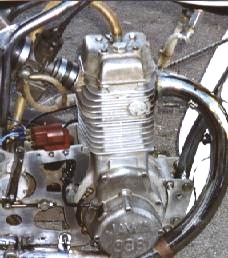
Simandl's workshop began to develop and manufacture larger track racing motorcycles which rivaled the twenty year old JAP's. In the early fifties Simandl's business was nationalised, becoming part of Kovovyroba Vlasim, and finally, in January 1964, being sold to Jawa. From this point on, Jawa now had all the pieces in place to become a major force in speedway, which is exactly what happened.
The first of the ESO machines seen in Britain were in the hands of Ove Fundin who had previously raced one at Rowley Park, Australia in 1961 before reverting to a JAP to win the 1967 World Championship at Wembley. The former company of Alec Jackson Ltd; in London were the original UK distributors of ESO engines in 1965, but in the following year, Barry Briggs became the sole UK concessionaire for the complete ESO machine.
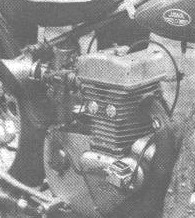
Apart from a short period in the 70's when Weslake challenged Jawa for supremacy over Speedway engines, Jawa have remained the leading engine manufacturers of purpose-built speedway engines up to the present day.
Pictured right is the first appearance of the Jawa 4-valve engine which had been developed to counteract the appearance of the Weslake and Street conversion engines, and was ready for full production in 1977. The earlier 2-valve Jawas had a gear drive to the magneto, whereas the 4-valve opted for a chain driven magneto and was seen as a great improvement.
* Additional Pre-War Information.
Jawa Speedway machines are in fact a lot older than many people think. Thanks to my friend Ben Ludolphy, additional information on earlier Jawa machines have come to light since this page was written.
The first Jawa speedway machines were built in 1934/35 which was a 500cc, OHV 2V machine. A more modern design was built some years later by G.W.Patchett (the chief designer at Jawa at that time) in 1937, the specs were as follows.
It was a 500 DOHC 2V Supercharged Twin Cylinder engine giving 50 BHP at 7000 rpm with a compression ratio of 16:1. The inlet ports lay in the front of the cylinder whilst the exhaust valves sat in the rear with a gear-driven DOHC between the Cylinders. Ignition was by magneto, the Roots supercharger was driven by a roller chain and in the supercharger intake manifold was a twin-float AMAL carb. The clutch was of the dry multiple type and the total weight of this machine was 125kg.
Similar to the Norton International, this particular machine also boasted front and rear suspension, and was used by German and Czech riders long after the war up until around 1952.
In 1947 it was Josef Linhart that built a new Czech engine and was named using the first two letters of both his first and last names, giving the JO-LI and was a virtual copy of the JAP engine and continued to be produced up until 1950. These engines were distinguishable by their Bronze Heads, few were made.
It was then in 1950 that Jaroslav Simandl bought all the remaining spare parts, castings and mouldings etc; and continued production of the ex-JOLI under his own name of ESO, at which point the story continues as above in the main story.

Below is a cut-away diagram of the Jawa 2-Valve engine.
Alternatively, you may wish to view a similar view of the JAP 2-Valve engine for a comparison.

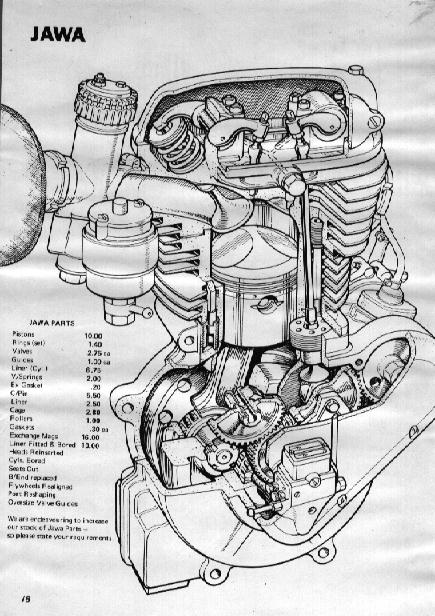
Minor edits Oct 2025